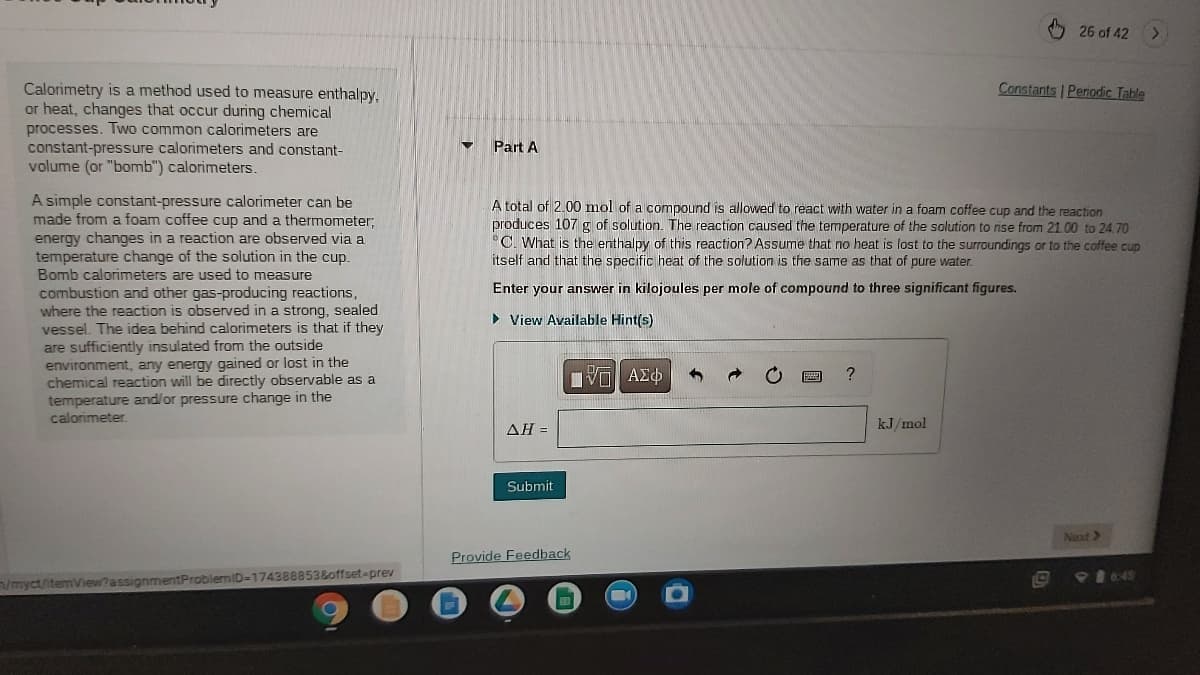A total of 2.00 mol of a compound is allowed to react with water in a foam coffee cup and the reaction produces 107 g of solution. The reaction caused the temperature of the solution to rise from 21.00 to 24, 70 °C. What is the enthalpy of this reaction? Assume that no heat is lost to the surroundings or to the coffee cup itself and that the specific heat of the solution is the same as that of pure water. Enter your answer in kilojoules per mole of compound to three significant figures. • View Available Hint(s) ΑΣΦ
A total of 2.00 mol of a compound is allowed to react with water in a foam coffee cup and the reaction produces 107 g of solution. The reaction caused the temperature of the solution to rise from 21.00 to 24, 70 °C. What is the enthalpy of this reaction? Assume that no heat is lost to the surroundings or to the coffee cup itself and that the specific heat of the solution is the same as that of pure water. Enter your answer in kilojoules per mole of compound to three significant figures. • View Available Hint(s) ΑΣΦ
General Chemistry - Standalone book (MindTap Course List)
11th Edition
ISBN:9781305580343
Author:Steven D. Gammon, Ebbing, Darrell Ebbing, Steven D., Darrell; Gammon, Darrell Ebbing; Steven D. Gammon, Darrell D.; Gammon, Ebbing; Steven D. Gammon; Darrell
Publisher:Steven D. Gammon, Ebbing, Darrell Ebbing, Steven D., Darrell; Gammon, Darrell Ebbing; Steven D. Gammon, Darrell D.; Gammon, Ebbing; Steven D. Gammon; Darrell
Chapter6: Thermochemisty
Section: Chapter Questions
Problem 6.109QP: A 21.3-mL sample of 0.977 M NaOH is mixed with 29.5 mL of 0.918 M HCl in a coffee-cup calorimeter...
Related questions
Question

Transcribed Image Text:O 26 of 42
Constants Periodic Table
Calorimetry is a method used to measure enthalpy,
or heat, changes that occur during chemical
processes. Two common calorimeters are
constant-pressure calorimeters and constant-
volume (or "bomb") calorimeters.
Part A
A simple constant-pressure calorimeter can be
made from a foam coffee cup and a thermometer;
energy changes in a reaction are observed via a
temperature change of the solution in the cup.
Bomb calorimeters are used to measure
A total of 2.00 mol of a compound is allowed to react with water in a foam coffee cup and the reaction
produces 107 g of solution. The reaction caused the temperature of the solution to rise from 21.00 to 24,70
C. What is the enthalpy of this reaction? Assume that no heat is lost to the surroundings or to the coffee cup
itself and that the specific heat of the solution is the same as that of pure water.
Enter your answer in kilojoules per mole of compound to three significant figures.
combustion and other gas-producing reactions,
where the reaction is observed in a strong, sealed
vessel. The idea behind calorimeters is that if they
are sufficiently insulated from the outside
environment, any energy gained or lost in the
chemical reaction will be directly observable as a
temperature and/or pressure change in the
calorimeter
• View Available Hint(s)
ΔΗ-
kJ/mol
Submit
Naxt>
Provide Feedback
roblemiD-174388853&offset-prev
VINS
/myct/itemView
Expert Solution
This question has been solved!
Explore an expertly crafted, step-by-step solution for a thorough understanding of key concepts.
Step by step
Solved in 2 steps

Recommended textbooks for you

General Chemistry - Standalone book (MindTap Cour…
Chemistry
ISBN:
9781305580343
Author:
Steven D. Gammon, Ebbing, Darrell Ebbing, Steven D., Darrell; Gammon, Darrell Ebbing; Steven D. Gammon, Darrell D.; Gammon, Ebbing; Steven D. Gammon; Darrell
Publisher:
Cengage Learning

Chemistry: The Molecular Science
Chemistry
ISBN:
9781285199047
Author:
John W. Moore, Conrad L. Stanitski
Publisher:
Cengage Learning

Chemistry
Chemistry
ISBN:
9781305957404
Author:
Steven S. Zumdahl, Susan A. Zumdahl, Donald J. DeCoste
Publisher:
Cengage Learning

General Chemistry - Standalone book (MindTap Cour…
Chemistry
ISBN:
9781305580343
Author:
Steven D. Gammon, Ebbing, Darrell Ebbing, Steven D., Darrell; Gammon, Darrell Ebbing; Steven D. Gammon, Darrell D.; Gammon, Ebbing; Steven D. Gammon; Darrell
Publisher:
Cengage Learning

Chemistry: The Molecular Science
Chemistry
ISBN:
9781285199047
Author:
John W. Moore, Conrad L. Stanitski
Publisher:
Cengage Learning

Chemistry
Chemistry
ISBN:
9781305957404
Author:
Steven S. Zumdahl, Susan A. Zumdahl, Donald J. DeCoste
Publisher:
Cengage Learning


Chemistry: An Atoms First Approach
Chemistry
ISBN:
9781305079243
Author:
Steven S. Zumdahl, Susan A. Zumdahl
Publisher:
Cengage Learning

Chemistry for Engineering Students
Chemistry
ISBN:
9781337398909
Author:
Lawrence S. Brown, Tom Holme
Publisher:
Cengage Learning